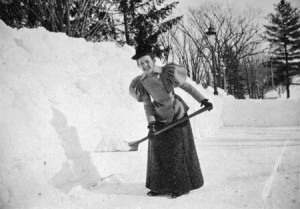 Shoveling – every New Englander’s favorite winter activity. And since we’ve had literally six feet of snow in less than three weeks, I’m sure everyone has done their fair share. Those of you who are lucky enough to own a snowblower or plow are certainly saving yourselves from potential injury (just watch your fingers). For the rest of us, here are some tips to staying injury-free during the winter season.
Shoveling – every New Englander’s favorite winter activity. And since we’ve had literally six feet of snow in less than three weeks, I’m sure everyone has done their fair share. Those of you who are lucky enough to own a snowblower or plow are certainly saving yourselves from potential injury (just watch your fingers). For the rest of us, here are some tips to staying injury-free during the winter season.
First and foremost, as the temperature drops, it’s important to keep warm by layering your clothes. Remember the Boston Yeti? He’s not cold, so try to dress more like him. When muscles get chilled, they are more likely to tear and become injured than if they have been kept warm. You want your muscles to be like a fine steak, not beef jerkey (that means keep hydrated, too). Keep your muscles pliable and flexible by adding layers as it gets colder. It’s better to have too many layers and remove some, than have too few and become injured because of it. And please don’t be that guy shoveling in basketball shorts with no shirt on. Nobody likes that guy.
If you don’t have the luxury of staying home during a snowstorm and need to head to work, it’s best to plan ahead when it comes to snow removal. Be sure to keep an eye on the weather the night before so you know when snow is expected, and therefore can give yourself a little extra time in the morning before work to shovel properly. Rushing can lead to poor form, which can lead to back injuries. We’ve seen plenty of our patients hurt themselves during the last few storms.
If Snowmageddon has you trapped in your house and you can’t make it to the gym, shoveling can actually provide you with good exercise – if done properly. But even if you identify yourself as a “gym rat”, you can still hurt yourself while shoveling. Since shoveling is not an exercise that most people perform at the gym, some muscles that are used to shovel can become “de-conditioned” over time from lack of use. These muscles can include those between your shoulders, in your upper and lower back, buttocks and legs. To avoid injury, it’s best to stretch, and even warm up by doing some jumping jacks before diving into that mountain of snow. Get pumped! That snow isn’t going to relocate itself.
So what is the best shoveling method to clear all that snow while preventing injury? Follow these simple tips to keep from cursing Mother Nature for your newly acquired sciatica:
- Rather than picking up large piles of snow, turning and then throwing, push the snow when possible.
- Keep a tight core during shoveling to protect your back properly.
- When bending, use a squatting motion, keeping the curve in your low back and holding your chest up.
- Do not bend at the waist and then twist to throw the snow – this is a recipe for injury. Instead, pick the snow up in front of you and move your entire body to the drop off location, dumping the snow or throwing it forward.
- If the snow is heavy, take smaller shovel-fulls.
- For fun, see if you can find your grill, garden gnomes, or patio furniture. It’s like a treasure hunt!
Finally, it’s important to pace yourself when shoveling, especially if you do not have a regular exercise routine. Jumping into hours of shoveling when you’re not usually active is the equivalent of heading out for a ten mile run when you’ve never run before. Bad idea. Muscle fatigue can leave you prone to injury, so take breaks every 10-15 minutes, or when you feel the need, in order to give your muscles some time to recuperate. Listen to your body and stop shoveling if you feel chest pain, become suddenly extremely tired, or have shortness of breath. These are signs that you may need immediate medical help.
Happy shoveling!
Leave a Reply